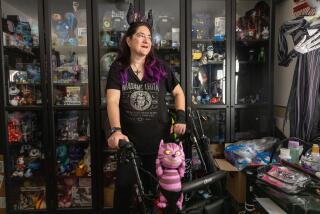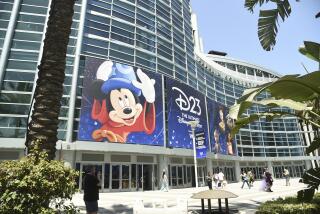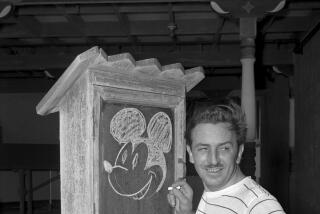Self-Styled Keepers of the Magic Kingdom
- Share via
ANAHEIM — For Rick West, finding stuffed animals for sale in Disneyland’s Main Street Penny Arcade was the final indignity.
The longtime Disney enthusiast and self-described theme park historian had chafed at the proliferation of churro carts, glow necklaces, light swords and other “cheap, carny” elements he considered an anathema to the vision of the Anaheim park’s founder.
But when a rack of grinning $10.95 Mickey and Minnie mouses turned up this summer where the quirky Cail-o-Scopes and the other antique amusement machines had been, he rode into cyberspace sounding the charge to “take back Walt Disney’s Disneyland.”
“If you want to fight for Disneyland, I beg you to do so with all your might,” West, 26, wrote in a recent posting to a popular online Disneyland bulletin board.
Casual observers may be confounded at such passion over a few stuffed animals and penny movie machines. But that is to underestimate the park’s emotional sway over some of its visitors, particularly Southern Californians reared in the shadow of Walt Disney’s original Magic Kingdom.
“That’s because Disneyland isn’t just a theme park,” says Philadelphia-based cultural historian Jamie O’Boyle. “It’s a cultural touchstone.”
Disney fan clubs and collectors’ societies operate worldwide. But the Anaheim park has spawned a unique subculture of hard-core enthusiasts who visit dozens of times a year and have become almost an extension of the show.
Disneyphiles such as West know cast members on a first-name basis, can trace the genealogy of practically every shop and attraction and wax enthusiastically about the vaunted Disney “magic.”
They also notice things the average visitor wouldn’t: a Coke bottle floating in the River of the Americas, a gradual reduction in full-service restaurants throughout the park--small flaws and changes they perceive as a threat to Walt Disney’s lofty standards of excellence.
In the past, such concerns would have taken the form of phone calls and notes to the park’s guest relations office. But through the help of Internet bulletin boards and Web sites, Disneyland enthusiasts have linked up to create a freewheeling public forum for their views.
Park patriots have responded to West’s electronic call to arms with a volley of complaints about crass merchandising, lax maintenance, rumored changes to long-standing attractions and the encroachment of corporate greed on Walt Disney’s legacy.
Passionate, open letters have surfaced asking Disneyland Resort President Paul Pressler to resign. Pressler’s smiling face and resume now adorn a cheeky, satirical Web site devoted to getting the youthful executive “promoted” right out of the park. One cyberrebel has suggested storming Tom Sawyer Island much like dope-smoking counterculturists did in 1970 to challenge park authority.
All the online complaints have irritated Disneyland officials, who declined to comment on the “Promote Paul Pressler” Web site, although they did remove the stuffed animals from the arcade.
The campaign isn’t likely to derail the fast-moving Pressler, the personable, 40-year-old merchandising whiz who has presided over two of the most successful seasons in Disneyland history since moving over from the Disney Stores in late 1994.
In a year when the Walt Disney Co. has been accused of everything from promoting a “homosexual agenda,” dumbing down the classics, exploiting Third World laborers and demonizing Arabs in its films, complaints about cheesy Hunchback souvenirs and gum on the Tomorrowland handrails probably won’t rattle the officials in Burbank.
And Disneyland remains one of the world’s top tourist attractions, setting an attendance record last year that made it the nation’s most-visited theme park.
Still, the flap is a reminder that ardent Disney supporters can be a pretty tough crowd when managers start messing with the house that Walt built.
“We probably sound like lunatics complaining about all these little things,” said Karen Kammann, a Disneyland lover from Northern California who saw the same piece of trash on Pirates of the Caribbean for four consecutive days when she visited Anaheim in June. “But it’s all those little things that add up to the magic. That’s what makes Disneyland different from other parks, and that’s what we don’t want to lose.”
*
At 9 on a bright Sunday morning, Disneyland’s Main Street couldn’t look more inviting. A marching band’s crisp melodies accompany visitors as they enter the park. The White Rabbit, Captain Hook, Chip (or maybe it’s Dale) pat children’s heads and sign their autograph books. Windows gleam in the faux small-town storefronts.
Scott Garner is starting his Sunday like he starts better than half of them each year, with breakfast at the Carnation Ice Cream Parlor and Restaurant.
He is dressed for the occasion in a red Disneyland T-shirt, straw hat with a smattering of Disney pins and a portable scanner clipped to his belt that allows him to eavesdrop on walkie-talkie conversations between park employees regarding ride closures, medical emergencies, shoplifters and the like.
“It’s a great way to find out what really goes on around here,” says the bearded, 37-year-old computer analyst after eating a waffle shaped like Mickey’s head.
Garner is joined this morning by Al Lutz, the West Hollywood designer of the “Promote Paul Pressler” Web site, who is resplendent in a multicolored Toontown cap.
The two are better versed in the park’s geography, traditions and customs than many Disneyland employees. The bigger mystery to them is what’s cooking inside the bright yellow Team Disney Anaheim administration building on the edge of the park, where the management suits dwell.
Garner was the first to post a fiery online letter demanding Pressler’s resignation. “Nothing personal,” he says. “I just wanted to get his attention.”
It’s tough to square how enthusiasts such as Garner and Lutz can be so thoroughly enchanted by the Disney “magic” when they know how all the gears and levers work.
At the Storybook Land Canal Boats, they note that Monstro’s eye is not blinking, nor is the customary steam rolling from the great whale’s blowhole. Garner spies a popped balloon and its dirty string hanging forlornly from a post in the queue, then observes that plants on one of the terraced islands need a trim. And that’s just the first attraction of the morning.
As the day progresses, Lutz will peruse the shops, checking merchandise for the dust that will tell which items aren’t moving. Inside Pirates of the Caribbean, Garner searches in vain for the shooting star over the river cabin and concludes a cast member has forgotten to turn it on.
“We’re not obsessed,” says Garner. “We’re normal people with jobs and families who just happen to love Disneyland. That’s why we do it.”
*
Despite Walt Disney’s now-famous declaration that “Disneyland will never be completed . . . as long as there is imagination left in the world,” the park’s loyal patrons have never accepted change as gracefully.
Forget that the cantankerous pack mules occasionally bit their child riders. Or that the clunky Flying Saucers broke down as frequently as they lifted off. Never mind that the Chicken of the Sea Pirate Ship and Restaurant nearly rotted into the water before Disney’s Imagineers scuttled the creaking hulk.
These old favorites have joined others on the Disneyland scrapheap. But no matter how well deserved an attraction’s demise, how dated its theme, how tired its concept, Disneyphiles have mourned its passing--not for what it is, but for what it was. Shocked patrons flooded Disneyland phone lines in late 1994 when the aging Skyway to Tomorrowland closed without warning, although many hadn’t ridden it since they were children.
“It’s as if their childhoods are preserved in amber there,” said Karal Ann Marling, a professor of art history and American studies who has examined Disney’s influence on American culture. “Disneyland has had such a profound emotional impact on its visitors that they feel they have a stake in what happens.”
Small wonder then that concern is growing over rumored urban renewal on Disneyland’s quaint Main Street, an area so central to Walt Disney’s vision that he designed his park so that every guest would have to pass through it.
Disneyland Web sites and bulletin boards have been frenetic with speculation in recent weeks that management plans to sack the Carnation Ice Cream Parlor and Restaurant, a fixture on Main Street since the park opened in 1955. Park fans also suspect a conspiracy to snuff Great Moments With Mr. Lincoln, Walt Disney’s heart-swelling tribute to America’s 16th president, which has anchored the Main Street Opera House since 1965.
Disneyland spokesman Tom Brocato emphatically denies such plans are afoot. He said Carnation’s decor and menu might be “modified,” but that its name and cherished table service will remain. And as for Mr. Lincoln, Brocato said Disney executives got the message in the late 1980s when patrons’ howls of protest staved off management’s vain attempt to yank the Audio-Animatronic emancipator.
Still, the very idea that Disney officials would consider--or ever considered--such a thing irritates fervent fans such as West.
“It’s a slap to their roots and to Walt’s vision,” he said. “It shows a lack of respect for history and tradition.”
*
Yet, some Disneyland annual pass-holders say the recent outpouring of cybercomplaints has little to do with nostalgia or preserving the park as a museum.
Lutz says he is more concerned about a perceived deterioration in Walt Disney’s uncompromising standards for the park--puritanical cleanliness, unfailing courtesy, exacting quality and attention to detail--as his company has gotten bigger, more corporate, more profit-driven.
“It’s the difference between a park run by a showman and one run by shopkeepers,” said Lutz, 39, a product manager for a small classical music label who has produced an unofficial, online visitor’s guide to Disneyland.
Park watchers have broadcast their dissatisfaction with the plastic plates that now substitute for real dinnerware at the French Market Restaurant. They lament the peeling paint on the giant decorative leaves outside Alice in Wonderland and the seemingly endless supply of homogenous movie merchandise being pushed throughout the park.
“We’re talking about an icon here, an institution,” said Paul Anderson, editor of Persistence of Vision, a historical journal devoted to Walt Disney’s creative legacy. “The place is almost sacrosanct to some people, which is why the smallest things can set them off.”
Despite their complaints, if attendance is any guide, Pressler is clearly doing something right.
Last year, Disneyland attracted an estimated 14.2 million guests through its turnstiles. Walt Disney’s flagship is on pace to shatter that mark in 1996, which would be quite an achievement in a year when Disneyland has no new blockbuster attraction to draw the crowds.
And if annual pass-holders are disgruntled, they certainly aren’t showing it at the gate. Thanks in part to better promotion and a price cut, the number of annual pass-holders has swelled under Pressler’s watch to an estimated 200,000.
“We satisfy most of the people most of the time,” Brocato said.
Other Disneyland employees aren’t as tactful, suggesting that hard-core park fanatics need to turn off their computers and get a life.
Still, all the cybergraffiti underscore the unique relationship between Disney and the public, says Margaret King, a Philadelphia-based cultural historian who has studied the entertainment giant extensively.
Like it or not, Disney has always come under closer scrutiny and been held to a higher standard than other companies. That’s partly because Disney has promoted itself as a bastion of excellence and virtue, and because it is in the business of selling dreams, not widgets. Thus King doesn’t find it surprising that Pressler is perhaps the only executive in the country to have a Web site devoted to a public discussion of his job performance.
“This is about values, not rides,” said King, founder of Cultural Studies & Analysis. “That’s why people are fixated on Disney and not IBM or AT&T.;”
More to Read
The biggest entertainment stories
Get our big stories about Hollywood, film, television, music, arts, culture and more right in your inbox as soon as they publish.
You may occasionally receive promotional content from the Los Angeles Times.










